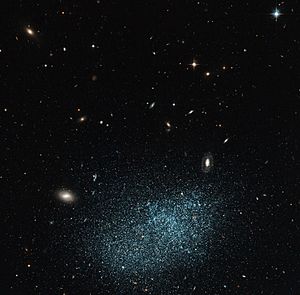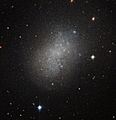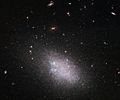Dwarf galaxy facts for kids
A dwarf galaxy is a small galaxy composed of up to several billion stars. This is a small number compared to our own Milky Way's 200–400 billion stars. The Large Magellanic Cloud, containing over 30 billion stars, is sometimes classified as a dwarf galaxy and sometimes as a full-fledged galaxy orbiting the Milky Way galaxy.
Formation of dwarf galaxies
Most galaxies, including dwarf galaxies, form in association with dark matter or out of gas containing metals. However, NASA's Galaxy Evolution Explorer space probe identified new dwarf galaxies forming out of gases lacking metals. These galaxies were in the Leo Ring, a cloud of hydrogen and helium around two massive galaxies in the constellation Leo.
Dwarf galaxies can be pulled toward and ripped by neighbouring spiral galaxies till they ultimately merge.
Local dwarfs

There are many dwarf galaxies in the Local Group: these small galaxies frequently orbit around larger galaxies, such as the Milky Way, the Andromeda Galaxy and the Triangulum Galaxy. A 2007 paper has suggested that many dwarf galaxies were created by tidal forces during the early evolution of the Milky Way and Andromeda. Tidal dwarf galaxies are produced when galaxies collide and their gravitational masses interact. Streams of galactic material are pulled out away from the parent galaxies and the halos of dark matter that surround them.
The Milky Way has more than 20 known dwarf galaxies orbiting it. Recent observations suggest the largest globular cluster in the Milky Way, Omega Centauri, is actually the core of a dwarf galaxy with a black hole in its center. It was at some time absorbed by the Milky Way.
Images for kids
-
The Large Magellanic Cloud, a satellite galaxy of the Milky Way
-
The Phoenix Dwarf Galaxy is a dwarf irregular galaxy, featuring younger stars in its inner regions and older ones at its outskirts.
See also
 In Spanish: Galaxia enana para niños
In Spanish: Galaxia enana para niños










